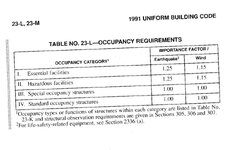zurch1818
Structural
- Feb 16, 2015
- 37
I'm hoping to pick the brain of some more experienced and seasoned engineers. I'm working on a six story college campus building in Wisconsin that has had a 50' tower that was constructed on top of it. The tower itself spans to two sets of exterior concrete columns that seem to be part of the lateral system on their based upon their rectangular shape orientation and the beams that spans between them. Under the current code (IBC 2015), I would classify this as a Risk Category III structure and would use corresponding windspeeds for the MWRS analysis.
When this tower was originally constructed (late 90's), the IBC wasn't the law of the land. Since that is before my time of practicing engineering, I'm clueless of how this analysis should have been conducted. I don't even know what Wisconsin's building code was at that time. I'm just curious from a historical standpoint, were there any provisions in the code that would have required this structure to be analyzed to more load than just an average building (say Risk Category II under today's code)?
When this tower was originally constructed (late 90's), the IBC wasn't the law of the land. Since that is before my time of practicing engineering, I'm clueless of how this analysis should have been conducted. I don't even know what Wisconsin's building code was at that time. I'm just curious from a historical standpoint, were there any provisions in the code that would have required this structure to be analyzed to more load than just an average building (say Risk Category II under today's code)?

